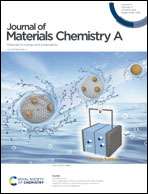Tailoring the structure and properties of epoxy–polyurea vitrimers via controllable network reconfiguration†
Abstract
Vitrimers can undergo topological rearrangement of their dynamic covalent networks, which endows these materials with the ability to be reprocessed and recycled. Utilizing the concept of vitrimers to develop novel functional applications for traditional materials is currently an interesting research focus. Here, we present an example of novel epoxy–polyurea based vitrimers equipped with dynamic aromatic disulfide linkages, meaning the structure and thermomechanical properties can be adjusted through controllable network reconfiguration. The stress relaxation behaviour of the epoxy–polyurea vitrimers correlates significantly with their network composition. After recycling, a narrow glass transition temperature and a higher elastic modulus were observed for the epoxy–polyurea vitrimers with the formation of homogeneous and orderly networks, while heterogeneous networks could be created by integrating epoxy–polyurea vitrimers with distinct glass transition temperatures through a “powder blend” method. Using the controllable network configuration strategy, different epoxy–polyurea vitrimers can be incorporated at the macroscopic and microscopic scale. Correspondingly, a multi-shape memory effect could also be achieved by post-processing via constructing isolation structures in different scales, using “powder blend” and “powder welding” methods.



 Please wait while we load your content...
Please wait while we load your content...